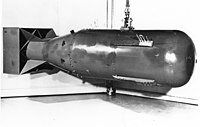
Photo from wikipedia
The present study is based on a pilot study, which showed that the Stepnogorsk area of Northern Kazakhstan represents sources of potential contamination of the living environment. The aim of… Click to show full abstract
The present study is based on a pilot study, which showed that the Stepnogorsk area of Northern Kazakhstan represents sources of potential contamination of the living environment. The aim of the study was measurement of outdoor gamma radiation levels, activity concentration in soil samples and assessment of external exposure to the public. According to our analysis, the highest ${\boldsymbol{H}}^{\ast}$(10) values ∼2870 nGy h-1 were detected in the Aqsu school territory, which were slightly higher than the control readings for this region. The average 226Ra, 232Th and 40K activities were 617.8 ± 3.2 Bq kg-1, 188.3 ± 2.9 Bq kg-1 and 731.5 ± 6.2 Bq kg-1, respectively. The annual effective dose received by the Aqsu population ranged from 0.08 to 3.5 mSv y-1, which was found higher by an order of magnitude than the upper annual dose limit. Changes in radiation background are an unfavourable factor for the population and may possibly become potential radiation risks for long-term effects.
Journal Title: Radiation protection dosimetry
Year Published: 2022
Link to full text (if available)
Share on Social Media: Sign Up to like & get
recommendations!